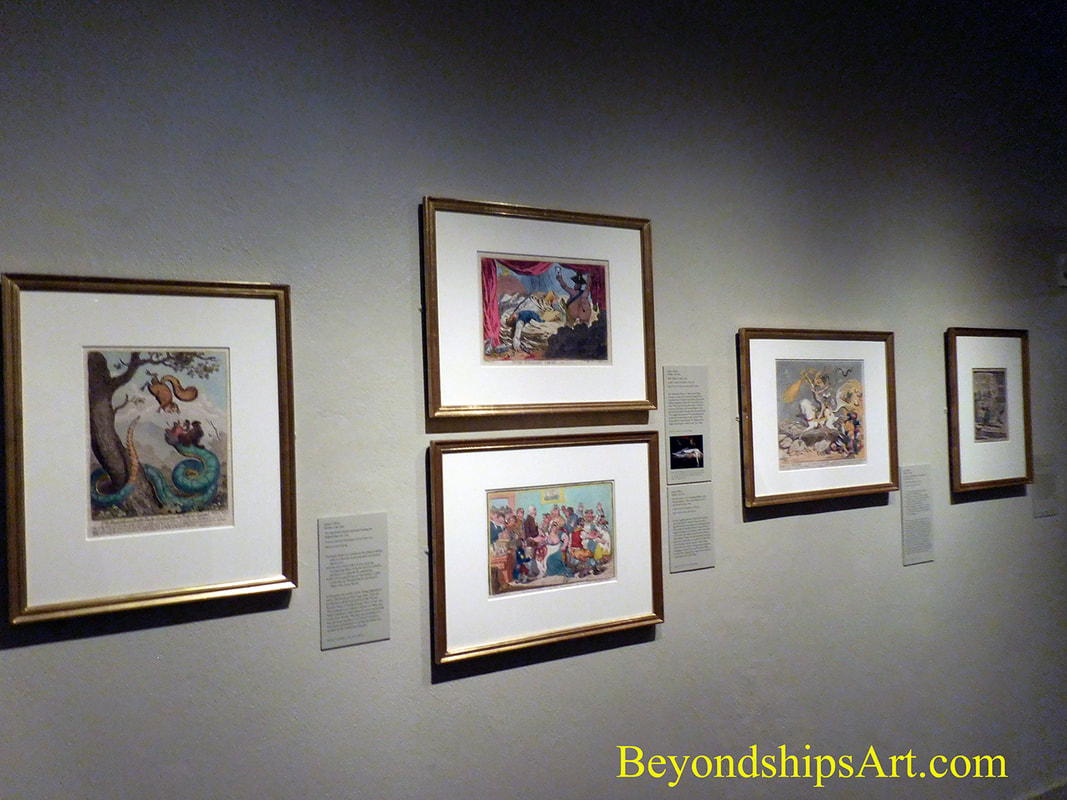ART REVIEW: Two Niche Exhibitions at the Morgan In addition to major blockbuster exhibitions, today's museums frequently present smaller niche exhibitions. These are usually made up of a few works drawn from the museum's own collection that focus on less well-known topics. In this review we look at two such exhibitions at the Morgan Library and Museum that touch upon the art of cartoonists.
“James Gillary and the Art of Caricature” presents seven prints from the Morgan's collection of over 1,000 prints by James Gillary. Often called the father of the political cartoon, Gillray was born in London in 1756. After a stint with a toupe of wandering players, Gillray enrolled at the Royal Academy of Art, supporting himself by doing engraving work. By the 1780s, he was creating caricature prints. These were very turbulent times encompassing the American Revolution, the French Revolution and the rise of Napoleon. Domestically, the political system was starting to change and there was vigorous, often ruthless, party politics. At the same time, fashions were changing radically. All of this was observed by Gillray and satorized in his prints. Gillray's prints were very popular and thus his art became a political and social force. In the seven hand-colored prints included in this exhibition, we see that then, as now, rulers and political leaders were targets of the cartoonist. In addition, other issues such as vaccination (a new concept at the time) as well as war and peace were controversial topics. Gillray exaggerated his figures and their gestures in order to make them comical. Another tactic was to place the figures in a scene that was well-known to the audience thus making it appear all the more ludicrous. The lengthy captions that he attached to some of the works seem unnecessary now. The second small exhibition at the Morgan is “A New Yorker Bouquet.” It includes ten cartoons and cover illustrations from the well-known magazine. Founded in 1925 by Harold Ross and Jane Grant, the New Yorker was intended to be a sophisticated humor magazine. While it has retained a humorous aspect, it is also known for publishing serious contemporary literature and top quality sophisticated cartoons. It remains one of the only major magazines to use drawings for its covers. All of the illustrations in this exhibition depict flowers in one way or another. In a cartoon from the early years of the magazine by Barbara Shermund, two society ladies are discussing the problems of marriage with a vase of flowers in the background. In a more recent cartoon, Roz Chast has reimagined Velázquez’s Spanish infantas as American girls-about-town with posies in hand. These cartoons do not have the bite of Gillray's cartoons but there is social comment here. Perhaps the most interesting of the cover illustrations is a work by Abe Birnbaum used as a cover in the 1960s. It is a colorful Matisse style vase and bouqet of flowers. However, if you look closely at the vase, there is a scene of a room with people and vases of flowers. Maybe it is a reflection of the flower shop in which the vase is sitting or maybe it is a world wihin the vase. |
Above: Making the best use of all available space - - A small exhibition of prints by James Gillray in a corridor at the Morgan.
Above: James Gillray's "The cow-pock,-or-The wonderful effects of the new inoculation!" commented upon fears of vaccination in London at the turn of the 19th century.
Below: Abe Birnbaum's combination drawing and collage was used as a cover of the New Yorker in the 1960s.
|
Art review - Morgan Library and Museum - Two Niche Exhibitions at the Morgan


